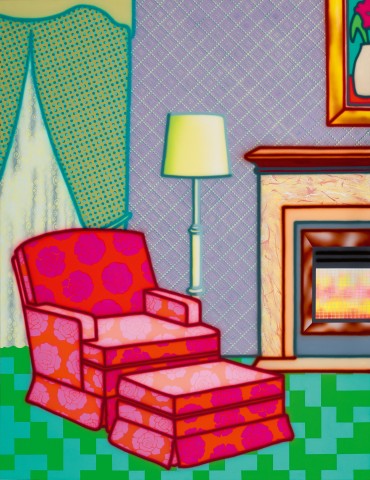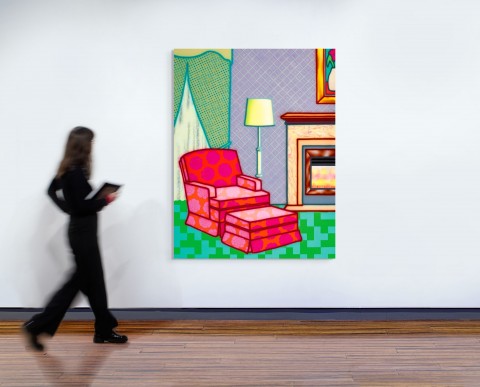(1951 - 1999)
Howard Arkley
New room, 1993
synthetic polymer paint on canvas
Tolarno Galleries, Melbourne
The Sigg Collection, Switzerland, acquired from the above in April 1994
Art and Australia, Fine Arts Press Pty Limited, Sydney, vol. 34, no. 4, 1997, front cover (illus.), p. 419 (illus.)
Howard Arkley Online Catalogue Raisonné: https://www.arkleyworks.com/blog/2009/12/09/new-room-1993/ [accessed March 2025]
‘The suburbs to me are quite simply, my life. They’re my childhood, and my formative years – they’re what formed me, both in my personal life, and in my artistic life.’1
By the time that Howard Arkley painted New room in 1993, the claustrophobic, exuberantly decorated spaces of the suburban interior had become a major preoccupation. These were showcased for the first time in his October 1992 exhibition, Mix ‘n Match: A Series of Suburban Interiors at Tolarno Galleries, Melbourne, and in his preceding collaboration with artist Juan Davila, Blue chip instant decorator: a room, 1991 – 92 (Benalla Art Gallery), which was later described by Davila as ‘a wonderful travesty’ with ‘an intentionally bastard result’.2 While referring to a well-known practice in interior design, Mix ‘n Match’s title could also be seen as an ironic take on the décor in most of the paintings, which, like New room, were replete with high-keyed colour and clashing decorative patterns on almost every available surface.3 Arkley continued this theme to great effect in his 1993 exhibition at Bellas Gallery, Brisbane, Recommended Rooms. The artist had returned to live in the suburbs with his partner (and later wife) Alison Burton in 1991, and through these works, and his iconic exteriors of suburban houses, he was to become the champion of a distinctly Australian vernacular:
‘Australian art has been dominated by the rural landscape, and I think there is something false and overrated – it’s romanticised or, at the very least, lopsided. Most of the population live in an urban environment. This environment affects us – the kinds of people that Australians are, and the way we behave. It affects our formative years, so it is a very important element.’4
However, while Arkley was the champion of the suburbs as subject matter, his works remain mute as to whether they are intended as a form of celebration or critique. There is certainly a sense that we don’t know what events unfold within these houses or their people-less interiors, and the dream of home ownership – which remains deeply embedded in the Australian psyche – is no doubt part of both their recognition and appeal. As curator Juliana Engberg has observed, Arkley’s interest in houses occupies the same territory as the mask in his practice – ‘They are all symbolic of the mapping of identity, the triple-fronted, the two-faced, the made-up and the made-over’ and are ‘part of his cosmetic construct of a world viewed from the other side of the fence.’5 What we do know, is that Arkley embraced the suburban house as a vehicle for pattern and decoration, and importantly, creative exploration, and that it also enabled him to playfully challenge prevailing notions of taste and artistic propriety. As he enthused:
‘Ordinary houses are filled with pattern. You go into a house where there is no art, no paintings, but it is filled with kind of second-degree imagery. The patterning around the fireplace, the carpet, and the different brick on the different houses, and the pattern between the gutter, the nature strip, the footpath; then you have the fence, then you have the green lawn, then you have house, then you have the tiles, then you have the blue sky… and I missed the bushes in between. It’s rich.’6
Prior to the creation of Blue chip instant decorator, Arkley’s friend and occasional collaborator John Nixon gave the artist a book that he had found in an op shop, with the quip, ‘Oh, this is blue chip, you’ll make money on this one Howard.’7 This publication – The Instant Decorator by Frances Joslin Gold (1976) – was to become the source for the compositions of many of the interior paintings that followed. Gold’s ‘how to’ guide featured transparent sheets over each outlined room so that the home decorator could place fabric swatches and colour samples underneath to test the way they looked. The exuberant patterning and decoration of Arkley’s interiors replicated this model to spine-tingling effect, as he overlaid and filled space with a multitude of patterns, colours and surface treatments that jostle and fight each other in kitschy confections of questionable taste. The extreme cropping of the composition of New room – as if it has been based on a magazine photograph that has been sliced in half, leaving only suggestive hints of the fireplace and painting that hangs above it – heightens the sense of claustrophobia that is characteristic of Arkley’s interiors. This sense of containment is also echoed by the artist’s assured airbrushing, which similarly reigns in the image’s dazzling array of stencilled designs, pattern and colour. The work’s title, New room, may convey a sense of pride in this elaborate decorative scheme, but its primness seems to indicate, in the spirit of suburban hosting, that it is a room ‘kept for best’.
Arkley’s representation of Australia at the Venice Biennale in 1999 with his exhibition The Home Show saw the artist’s reputation skyrocket, but New room was acquired for the Sigg Collection in 1994, well before this occurred. An astute and informed collector, businessman and diplomat Uli Sigg acquired the work close to the time it was made, adding it to his significant collection of international contemporary art. Sigg had also amassed one of the world’s largest collections of contemporary Chinese art, and today, this forms the lynchpin of the collection of Hong Kong’s M+ art museum.
1. Howard Arkley, cited in Wyzenbeek, T. (dir.), Howard’s Way, ABC-TV Arts, 1999
2. O’Connell, S., BLUE CHIP INSTANT DECORATOR: Howard Arkley & Juan Davila (interviewed) at: http://artdes.monash.edu.au/globe/issue3/decorate.html (accessed 16 June 2025)
3. The title of the exhibition was borrowed from a book in Arkley’s collection: Mary Gilliat’s Mix & Match Decorating Book (1984). See Gregory, J., Carnival in Suburbia: The Art of Howard Arkley, Cambridge University Press, Melbourne, 2006, p. 30
4. Howard Arkley, cited in Crawford, A. & Edgar, R., ‘Unpublished interview with the authors’ in Spray: The Work of Howard Arkley, Craftsman House, Sydney, 1997, p. 88
5. Engberg, J., ‘Howard Arkley’, Art & Text, no. 41, 1992, p. 102
6. Howard Arkley, cited in Wyzenbeek, op. cit.
7. This also led to the title of the Arkley and Davila collaboration discussed above. See ‘Unpublished interview with Arkley conducted by Stephen O’Connell (Zagala)’, 24 November 1995, cited in Gregory, op. cit. p. 32
KELLY GELLATLY

